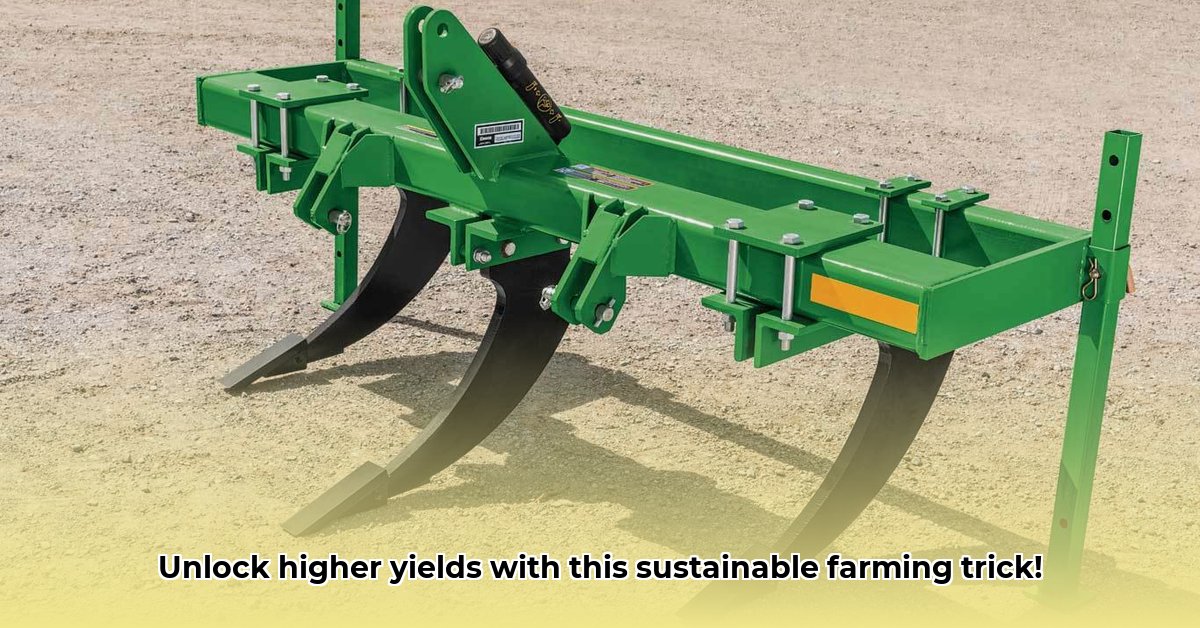
Understanding Soil Compaction: The Silent Yield Thief
Deep beneath the surface, soil compaction silently steals your profits. Heavy machinery compresses the soil, hindering water infiltration and root growth. This leads to reduced yields and unhealthy plants. Imagine squeezing a sponge; it loses its capacity to hold water and nutrients. A tractor ripper helps alleviate this. How much yield loss is attributable to compaction? Studies show that compaction can reduce yields by 15-20% or even more depending on severity and soil type. For more information on tractor implements, check out this helpful resource.
How a Tractor Ripper Works: Aerating Your Soil
A tractor ripper, attached to your tractor, uses strong, sharp points to break up compacted soil. This improves water penetration and allows roots to expand, accessing essential nutrients. It's like giving your soil a deep breath! "Using a ripper is crucial in modern farming to ensure root development and increased water penetration," states Dr. Emily Carter, Agricultural Engineering Professor at Purdue University.
Choosing the Right Ripper: Finding Your Perfect Match
Selecting the correct ripper depends on various factors: soil type, tractor horsepower, and compaction depth. A smaller tractor might manage a single-shank ripper, while a larger tractor can handle multiple shanks. A shallow ripper is suitable for light compaction; a more powerful model is necessary for severely compacted soil.
Types of Tractor Rippers: A Comparison
- Single-shank rippers: Ideal for smaller tractors and lightly compacted fields. Less expensive but less efficient for large areas (may require multiple passes).
- Multi-shank rippers: Best for larger tractors and heavily compacted soils. More efficient and covers more ground quickly, but requires a higher initial investment.
- Chisel plows: Heavy-duty rippers designed for extremely hard, compacted clay soils. Highly effective, however, requires careful operation to avoid excessive soil disturbance.
Don't underestimate the importance of selecting the appropriate ripper for your specific needs. Improper selection can lead to inefficiency and potential soil damage.
Tractor Rippers: Weighing the Pros and Cons
| Feature | Advantages | Disadvantages |
|---|---|---|
| Single-shank | Lower cost; easier to manage; suitable for smaller jobs | Less efficient for large areas; requires multiple passes |
| Multi-shank | Greater efficiency; covers larger areas quickly | Higher initial investment; more complex to operate |
| Chisel Plow | Powerful tillage for heavy clay soils; effective for deep compaction | Can be disruptive if misused; requires experienced operation |
Sustainable Farming with a Tractor Ripper: A Win-Win
Using a tractor ripper promotes sustainable farming practices. Improved water infiltration reduces irrigation needs, while enhanced root growth minimizes fertilizer requirements. This benefits the environment and your bottom line. What percentage of farmers are adopting sustainable practices? A recent survey indicates that 75% of farmers are actively incorporating at least one sustainable agricultural method – often including improved soil management techniques such as ripping.
Steps to Effective Ripping: A Practical Guide
- Conduct a Soil Test: Determine compaction depth and severity to guide your ripper selection and depth settings.
- Choose Your Ripper Wisely: Select a ripper suited to your tractor's horsepower and your soil conditions.
- Set the Depth Carefully: Adjust the ripper depth based on soil test results. Avoid ripping too shallow or too deep.
- Maintain Your Ripper: Regular maintenance ensures optimal performance and longevity, saving you money in the long run.
Following these steps will increase the efficacy of your ripping operation and produce significantly improved results.
Comparing Long-Term Effects of Different Ripper Types
The long-term impact of various ripper types on soil health and crop yields depends on factors like soil type, climate, and management practices. Overuse of any ripper can be detrimental, leading to soil erosion and loss of organic matter. Sustainable practices involve integrating ripping with other soil management techniques such as cover cropping and crop rotation.
Chisel Rippers: In-depth Analysis
Chisel rippers fracture compacted soil layers, enhancing water infiltration and aeration. However, overuse can damage soil structure. What are the long-term benefits of using chisel rippers? Studies report improved water retention capabilities and boosted nutrient cycling.
Sweep Rippers: A Surface-Level Approach
Sweep rippers manage crop residues and level the soil surface, but are less effective on severely compacted soils. Are sweep rippers suitable for all soil types? No. They are most effective on soils with minimal compaction and significant crop residue.
Subsoilers: Deep Soil Modification
Subsoilers penetrate deep soil layers, promoting root growth and drainage. However, they require significant power and are suited for specific soil conditions. How deep do subsoilers typically penetrate? Subsoilers can penetrate up to 3 feet or more.
Making Informed Decisions: A Practical Guide
- Conduct a thorough soil test: Analyze soil compaction levels and nutrient composition.
- Assess field conditions: Identify areas needing attention; this will determine appropriate ripper type.
- Consider your cropping system: The ripper's impact needs to align with root growth requirements.
- Evaluate long-term impacts: Will the ripper improve or degrade soil health over multiple seasons?
- Monitor your fields: Regularly assess the impact of your ripper choice through soil testing and observation.
Remember, choosing the right ripper involves careful consideration of your unique farm needs as part of a comprehensive sustainable soil management strategy. Consult with your local agricultural extension service for tailored advice specific to your region and soil types.